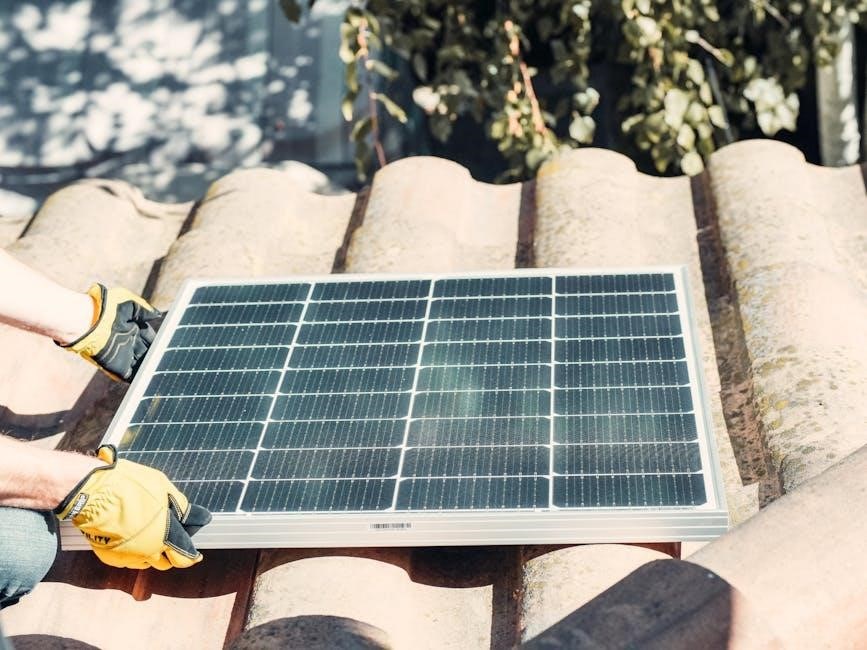Solar panel installation diagrams are essential visual guides for installing solar systems, ensuring safety, efficiency, and compliance with technical standards. They provide step-by-step instructions, component layouts, and wiring details, catering to both professionals and DIY enthusiasts. These diagrams are crucial for understanding system requirements, optimizing performance, and troubleshooting common issues, making them indispensable for successful solar panel setups.
1.1 Importance of Solar Panel Installation Diagrams
Solar panel installation diagrams are crucial for ensuring proper system setup, safety, and efficiency. They provide clear visual guidance, helping installers avoid errors and comply with standards. These diagrams detail component connections, wiring, and optimal layouts, making installations more efficient. They are essential for both professionals and DIY enthusiasts, ensuring systems perform optimally and safely while preventing costly mistakes.
1.2 Brief Overview of Solar Panel Systems
A solar panel system converts sunlight into electricity using photovoltaic panels, inverters, and mounting structures. It includes components like solar panels, inverters, charge controllers, and wiring. These systems can be grid-tied or off-grid, providing clean energy solutions. They are designed to harness renewable energy efficiently, reducing reliance on traditional power sources while offering environmental benefits and cost savings over time.

Understanding Solar Panel System Requirements
Assessing energy needs, location, climate, and budget are crucial for determining the appropriate solar panel system size and configuration. Proper planning ensures efficient energy generation and cost-effectiveness.
2.1 Assessing Energy Needs and Consumption
Evaluating your energy requirements involves analyzing past utility bills, identifying peak usage patterns, and considering future energy demands. This process ensures your solar system is appropriately sized to meet your needs, balancing cost and efficiency. Tools like load calculators and energy audits help determine the optimal configuration, while considering factors like shading and appliance upgrades ensures accurate planning for your solar installation.
2.2 Location and Climate Considerations
Location and climate play a crucial role in solar panel efficiency. Areas with ample sunlight and minimal shading are ideal. Southern-facing panels in the northern hemisphere maximize energy production, while northern-facing panels are better in the southern hemisphere. Climate factors like temperature, humidity, and wind speed also impact performance. Ensuring your system is tailored to local conditions and building codes guarantees optimal energy generation and durability over time.
2.3 Budget and Cost Estimation
Budget and cost estimation are critical for planning a solar panel installation. Initial costs include panels, inverters, mounting structures, and permits. DIY setups can reduce labor expenses, while professional installations may offer warranties. Research incentives, tax credits, and rebates to offset costs. Long-term energy savings often justify the upfront investment. Accurate cost estimation ensures a financially viable and sustainable solar energy solution for your needs.
Components of a Solar Panel System
A solar panel system includes panels, inverters, mounting structures, charge controllers, and wiring. These components work together to generate, regulate, and distribute clean energy efficiently.
3.1 Solar Panels: Types and Specifications
Solar panels come in types like monocrystalline, polycrystalline, and thin-film, each with varying efficiencies and costs; Specifications include power rating, voltage, current, and efficiency. Understanding these factors helps in selecting the right panels for energy needs and system design, ensuring optimal performance and compatibility with other components like inverters and mounting structures.
3.2 Mounting Structures and Racking Systems
MOUNTING STRUCTURES AND RACKING SYSTEMS ARE CRUCIAL FOR SECURING SOLAR PANELS. THEY INCLUDE ROOF MOUNTS, GROUND MOUNTS, AND TRACKERS. THESE SYSTEMS ENSURE PANELS ARE STURDY, WEATHER-RESISTANT, AND PROPERLY ANGLED FOR MAXIMUM ENERGY CAPTURE. DURABILITY AND ADJUSTABILITY ARE KEY CONSIDERATIONS TO WITHSTAND ENVIRONMENTAL STRESSORS AND OPTIMIZE PERFORMANCE. PROPER INSTALLATION OF THESE SYSTEMS IS VITAL FOR SAFETY AND EFFICIENCY.
3.3 Inverters and Charge Controllers
INVERTERS AND CHARGE CONTROLLERS ARE CRUCIAL COMPONENTS IN SOLAR PANEL SYSTEMS. INVERTERS CONVERT DC POWER FROM PANELS TO AC FOR HOME USE, WHILE CHARGE CONTROLLERS REGULATE ENERGY FLOW TO BATTERIES. PROPER SIZING AND CONFIGURATION ENSURE EFFICIENT ENERGY MANAGEMENT, SAFETY, AND SYSTEM RELIABILITY. THESE DEVICES PLAY A KEY ROLE IN OPTIMIZING PERFORMANCE AND PREVENTING OVERCHARGING OR POWER LOSS.
Mounting and Installation Process
SOLAR PANEL INSTALLATION INVOLVES ASSESSING THE ROOF OR GROUND CONDITION, CHOOSING MOUNTING STRUCTURES, AND SECURING PANELS FIRMLY. PROPER ALIGNMENT AND LEVELING ENSURE OPTIMAL ENERGY CAPTURE AND DURABILITY.
4.1 Roof Mounting: Best Practices
ROOF MOUNTING REQUIRES ASSESSING STRUCTURAL INTEGRITY AND CONDITION. CHOOSE MOUNTING HARDWARE THAT PREVENTS LEAKS AND ENSURES DURABILITY. PROPER ALIGNMENT AND LEVELING MAXIMIZE ENERGY PRODUCTION. SECURE PANELS FIRMLY TO WITHSTAND WEATHER CONDITIONS. AVOID SHADING AND ENSURE THE ROOF IS IN GOOD CONDITION FOR OPTIMAL PERFORMANCE. FOLLOW INSTALLATION DIAGRAMS TO ENSURE COMPLIANCE WITH SAFETY AND TECHNICAL STANDARDS.
4.2 Ground Mounting: Advantages and Setup
GROUND MOUNTING OFFERS FLEXIBILITY, EASE OF ACCESS, AND BETTER ANGLE CONTROL. IT IS IDEAL FOR OPEN SPACES WITH SUITABLE SUNLIGHT. INSTALLATION INVOLVES CONCRETE FOUNDATIONS OR ANCHORS FOR STABILITY. USE RACKING SYSTEMS TO ADJUST PANEL TILT AND ORIENTATION. ENSURE PROPER GROUND PREPARATION AND WIRING PROTECTION. FOLLOW DIAGRAMS TO MAXIMIZE EFFICIENCY AND SAFETY, MAKING IT A PRACTICAL CHOICE FOR MANY SOLAR INSTALLATIONS.
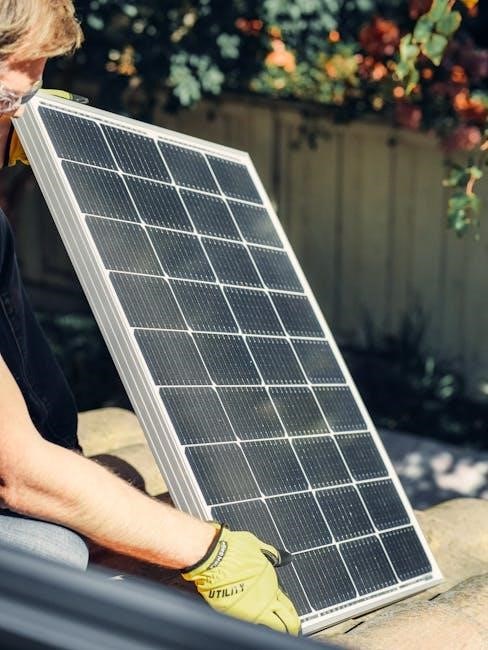
Wiring and Electrical Connections
Proper wiring and electrical connections are crucial for solar panel efficiency and safety. Follow diagrams to ensure correct series or parallel configurations and adhere to safety standards.
5.1 Series vs. Parallel Connections: Which is Better?
Choosing between series or parallel connections depends on your solar system’s voltage and current needs. Series connections increase voltage while keeping current low, ideal for higher voltage requirements. Parallel connections maintain voltage while increasing current, suitable for lower voltage systems. Diagrams guide you to optimize your setup for efficiency and compatibility with inverters and charge controllers, ensuring maximum energy output and system safety.
5.2 Safety Practices for Electrical Wiring
Proper electrical wiring is critical for solar panel safety. Ensure all connections are secure, use overcurrent protection devices, and follow local electrical codes. Diagrams highlight grounding requirements and disconnect switches for emergency shutdowns. Avoid loose wires, overload circuits, and always test for voltage before handling. Regular inspections prevent arcing and overheating, ensuring a safe and reliable solar power system. Adhere to manufacturer guidelines and safety standards.
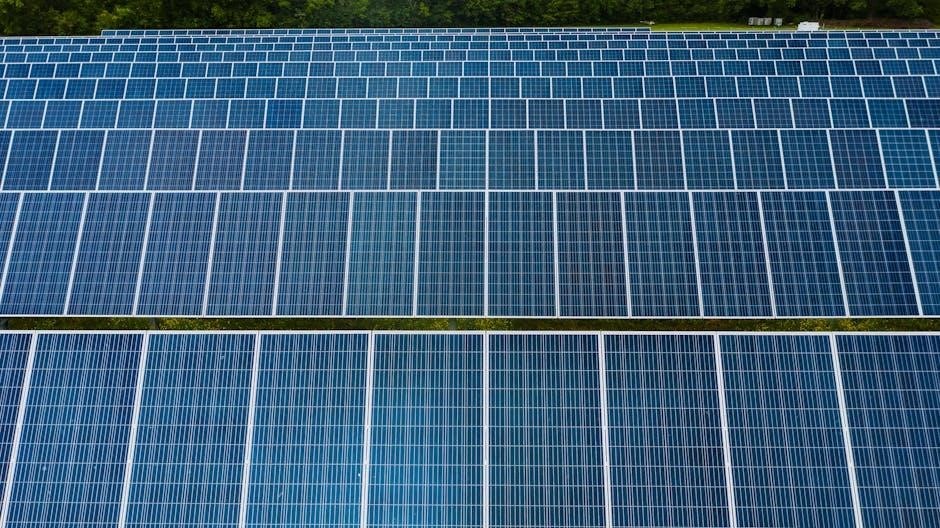
Inverter Installation and Configuration
Inverter installation is crucial for converting DC power to AC. Choose the right type, such as string or micro-inverters, and follow configuration steps for optimal performance. Ensure proper setup, parameter programming, and testing to guarantee efficient energy conversion. Always refer to manufacturer guidelines and safety protocols for a secure and reliable system operation.
6.1 Types of Solar Inverters
Solar inverters come in various types, including string inverters, micro-inverters, and power optimizers. String inverters are the most common, suitable for larger systems, while micro-inverters optimize each panel’s performance. Power optimizers enhance energy production by maximizing output per panel. Each type has unique benefits, and selecting the right one depends on system size, panel configuration, and specific energy needs; Proper installation ensures efficient energy conversion and reliable performance.
6.2 Sizing and Optimizing Your Inverter
Correctly sizing your inverter is crucial for maximizing energy production and system efficiency. The inverter must match the solar array’s output voltage and power requirements. Undersizing can lead to energy loss, while oversizing may increase costs. Consider factors like peak sun hours, temperature effects, and future expansion needs. Proper optimization ensures the inverter operates at maximum efficiency, converting DC power to AC effectively. Always refer to the manufacturer’s specifications for optimal performance.
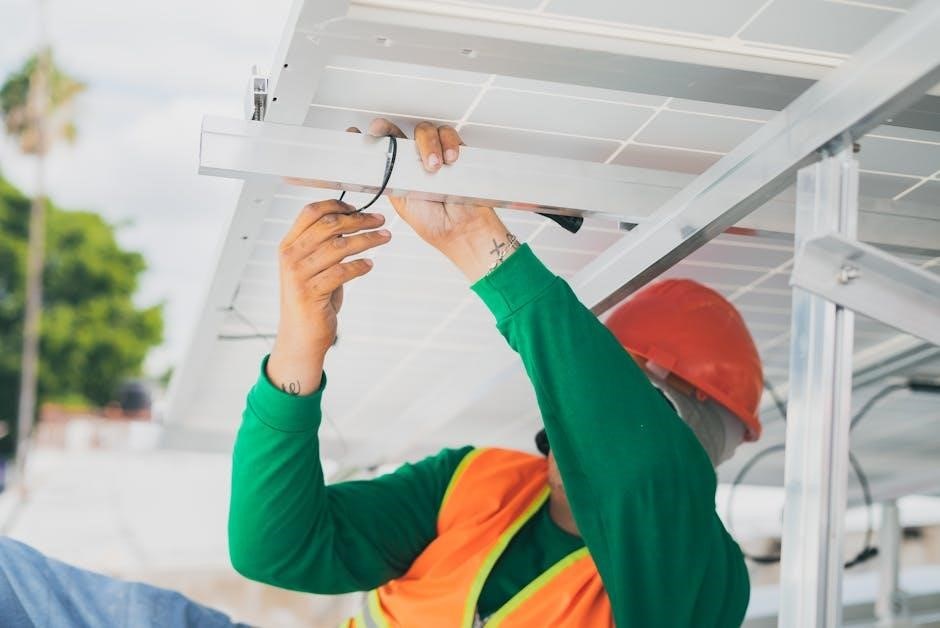
Safety Precautions and Best Practices
Always wear protective gear, follow electrical codes, and handle panels safely to avoid injuries. Ensure proper installation and emergency shutdown preparedness for system maintenance and repairs.
7.1 Handling Solar Panels Safely
Always wear protective gear, including gloves and safety glasses, when handling solar panels. Lift panels securely by the frame, avoiding glass surfaces. Never drag panels, as this can cause damage. Ensure panels are placed on soft, dry surfaces to prevent breakage. Follow manufacturer guidelines for handling and storage to minimize risks of injury and system damage.
7.2 Emergency Shutdown Procedures
In case of an emergency, immediately disconnect the solar system from the power supply. Switch off the inverter and isolate the system using emergency disconnects. Ensure all personnel wear appropriate PPE. Follow the manufacturer’s shutdown procedures to safely disable power generation and storage. Always verify the system is completely de-energized before performing any maintenance or repairs to ensure personal and system safety.
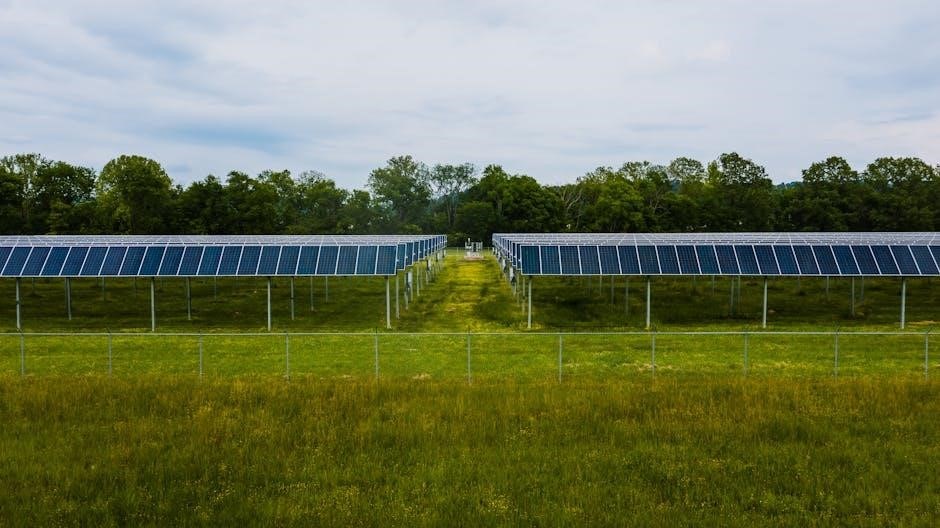
Maintenance and Monitoring
Regular inspections and performance monitoring are crucial for optimal solar panel efficiency. Use monitoring tools to track energy production and detect potential issues early, ensuring system longevity.
8.1 Regular Inspections and Cleaning
Regular inspections ensure solar panels operate efficiently, identifying dust, debris, or damage. Cleaning panels with water and soft cloths maximizes energy absorption. Inspect mounting structures for stability and check electrical connections for wear or damage. Schedule professional inspections annually to maintain optimal performance and address potential issues before they escalate, ensuring long-term reliability and energy production.
8.2 Monitoring System Performance
Monitoring solar panel performance ensures optimal energy production. Use specialized tools like inverters or software to track energy output, voltage, and system health. Regularly review data to identify trends, detect faults, or adjust settings. Remote monitoring solutions allow real-time insights, enabling prompt issue resolution. This practice maximizes efficiency, reduces downtime, and ensures your solar system operates at its best capacity year-round.
Performance Optimization
Optimizing solar panel performance involves adjusting orientation, tilt, and ensuring minimal shading. Regular cleaning and efficient component setup maximize energy output and system longevity.
9.1 Orientation and Tilt of Solar Panels
Proper solar panel orientation and tilt are critical for maximizing energy production. Panels should face north in the southern hemisphere and south in the northern hemisphere for optimal sunlight exposure. The tilt angle typically matches the location’s latitude, ensuring maximum solar radiation capture. Adjustments may be needed for seasonal variations or specific installation requirements. Proper alignment enhances efficiency and overall system performance significantly.
9.2 Reducing Shading and Obstructions
Minimizing shading and obstructions is crucial for maximizing solar panel efficiency. Trees, buildings, and other structures can block sunlight, reducing energy production. Regularly trimming trees and relocating obstructions helps maintain optimal conditions. Proper panel placement and mounting structures can also mitigate shading issues. Assessing site conditions beforehand ensures minimal interference, enhancing overall system performance and energy output throughout the day.
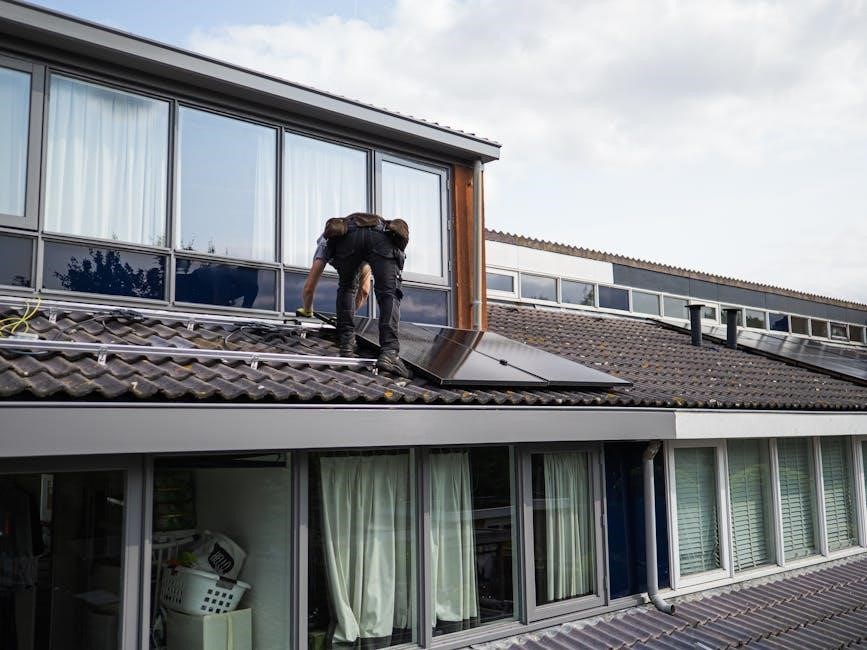
Tools and Materials Needed
Essential tools include drills, wrenches, screwdrivers, and wire cutters. Materials like solar panels, mounting hardware, connectors, and adhesives are required for a secure and efficient installation setup.
10.1 Essential Tools for Installation
Key tools include drills, impact wrenches, and screwdrivers for mounting. Wire cutters and strippers are necessary for electrical connections. A multimeter ensures proper voltage checks, while a level tool guarantees precise panel alignment. Safety gear like gloves and safety glasses is crucial. Anchors, clamps, and bolts secure panels firmly. These tools ensure a safe, efficient, and professional solar panel installation process, as detailed in installation diagrams.
10.2 Recommended Materials and Accessories
Essential materials include sturdy mounting brackets, rails, and clamps for secure panel installation. High-quality wiring, connectors, and junction boxes ensure reliable electrical connections. Surge protectors and circuit breakers enhance system safety. Durable fasteners and weatherproof adhesives prevent leaks and corrosion. These components, as detailed in solar panel installation diagrams, ensure a robust, efficient, and long-lasting solar panel system, meeting both performance and safety standards.
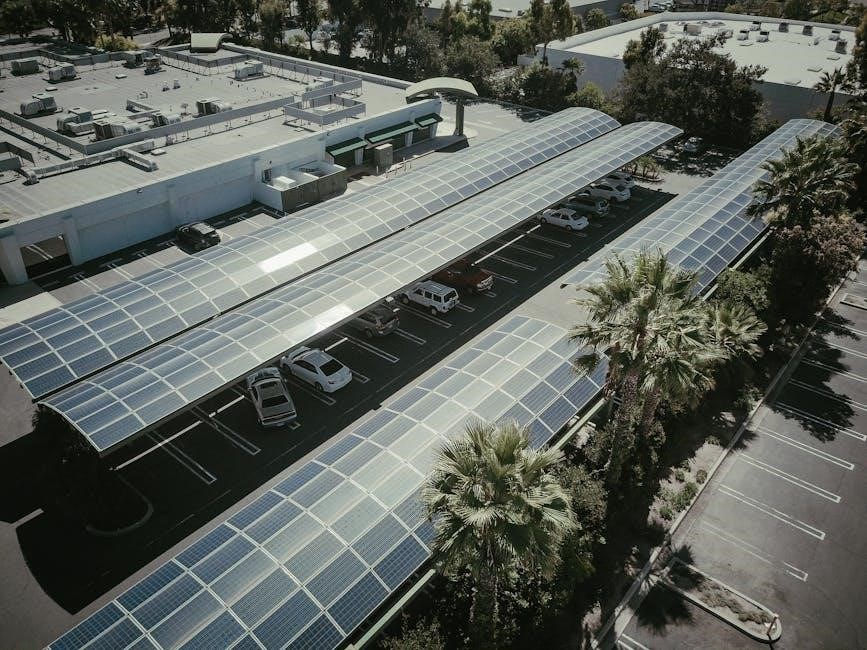
Regulations and Compliance
Ensure compliance with local building codes, electrical standards, and environmental regulations. Obtain necessary permits and approvals before installation to avoid legal issues and safety hazards.
11.1 Permits and Approvals Required
Installing solar panels requires obtaining necessary permits and approvals to ensure compliance with local regulations. Typically, building and electrical permits are needed, along with environmental or zoning approvals in some areas. Failure to secure these can lead to legal issues or system shutdowns. Always consult local authorities to determine specific requirements and ensure your installation meets all safety and legal standards.
11.2 Building Codes and Standards
Building codes and standards ensure solar installations meet safety, structural, and electrical requirements. These codes dictate how panels are mounted, wired, and integrated into buildings. Compliance with national and local regulations, such as the National Electric Code (NEC), is mandatory. Adhering to these standards ensures system reliability, safety, and legal compliance, while also guaranteeing optimal performance and durability of the solar panel system over time.
Troubleshooting Common Issues
Troubleshooting solar panel issues involves identifying faults like faulty wiring, soiled panels, or shading. Regular inspections and system monitoring help detect problems early. Always refer to installation diagrams to resolve issues effectively and ensure optimal performance.
12.1 Identifying and Fixing System Faults
Identifying faults in solar systems requires checking for issues like faulty inverters, loose connections, or damaged panels. Use monitoring systems to detect performance drops. Refer to installation diagrams for troubleshooting steps. Ensure all components are properly connected and functioning. Regular maintenance and inspections can prevent major issues, maximizing system efficiency and longevity. Always follow safety guidelines when repairing faults.
12.2 Common Mistakes to Avoid
Common mistakes include incorrect panel orientation, using inferior materials, and improper electrical connections. Neglecting regular maintenance and ignoring shading issues can reduce efficiency. Ensure all components are compatible and installed according to diagrams. Avoid overloading systems and always follow safety protocols. Proper planning and adherence to installation guidelines can prevent these errors, ensuring optimal performance and longevity of the solar panel system.
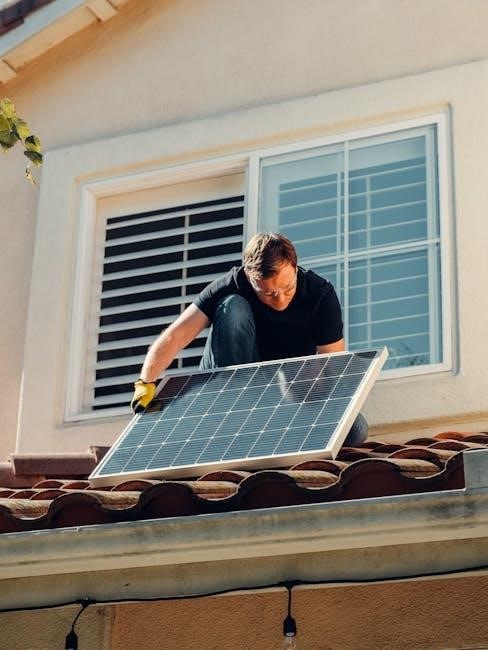
Future Trends in Solar Panel Installation
Future trends include advanced recycling technologies, innovative mounting methods, and higher efficiency solar panels. These developments aim to enhance sustainability, reduce costs, and improve system performance effectively.
13.1 Advances in Technology
Advances in solar technology are revolutionizing installations, with innovations like bifacial panels, perovskite cells, and smart inverters improving efficiency and performance. These technologies enable higher energy output, reduced costs, and enhanced system integration. Additionally, recycling advancements are making solar panels more sustainable, while better mounting and wiring solutions simplify installations. Such innovations are driving the solar industry toward a greener, more efficient future globally.
13.2 Emerging Installation Methods
Emerging installation methods, such as floating solar panels and solar skin technology, are transforming how systems are deployed. Dual-axis tracking systems and community solar projects are gaining traction, offering improved efficiency and accessibility. Plug-and-play systems simplify DIY installations, while innovative mounting solutions reduce environmental impact. These advancements are making solar energy more adaptable, efficient, and accessible for diverse applications, driving wider adoption globally.
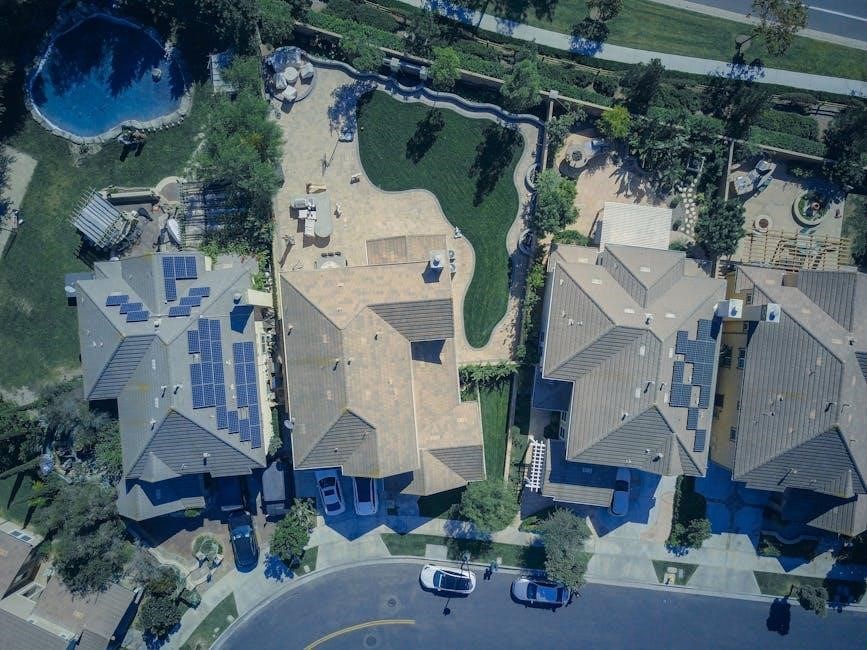
Solar Panel Installation Guides and Diagrams
Solar panel installation guides and diagrams provide comprehensive visual instructions for successful setups. Trusted sources offer reliable diagrams, essential for both professionals and DIY enthusiasts to ensure safe, efficient, and compliant installations.
14.1 Where to Find Reliable Installation Diagrams
Reliable solar panel installation diagrams can be found on official manufacturer websites, renewable energy forums, and trusted DIY platforms. Platforms like Santan Solar, Instructables, and Home Solar Experts offer detailed guides. Additionally, educational resources and solar installer communities provide verified diagrams. Always ensure diagrams are from reputable sources to guarantee safety and efficiency in your solar panel setup.
14.2 Using Diagrams for DIY Installations
DIY enthusiasts can effectively use solar panel installation diagrams to guide their projects. These diagrams provide clear, step-by-step visual instructions, ensuring proper system setup. They highlight safety practices, wiring configurations, and mounting techniques. By following these diagrams, individuals can achieve professional-grade installations, minimizing errors and maximizing efficiency. Always cross-reference diagrams with manufacturer instructions for optimal results.
Solar panel installation diagrams are indispensable tools for both professionals and DIY enthusiasts, ensuring safe, efficient, and compliant setups. They simplify complex processes, reduce errors, and enhance system performance. By following these diagrams, individuals can harness renewable energy effectively, contributing to sustainability and cost savings. Embrace solar energy with confidence, using these visual guides to achieve a successful and lasting installation.
